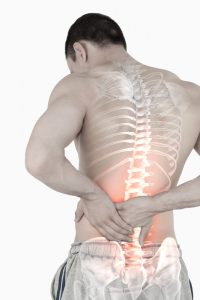All that you need to know about causes, symptom’s diagnosis and treatment

How to identify whether there is a specific cause for low back pain
In general it is quite difficult to find a specific cause. It can be that the muscles of your back have been overloaded or that your posture while standing and/or sitting is not correct. A relatively common reason for low back pain is when from one moment to another it seems that your back is ‘locked’ and you are not able to move anymore. Other factors that can evoke low back pain are poor health, stress and long hours behind the wheel (truck drivers!).
What are the symptoms of low back pain?
of course the most predominant symptom is pain in the lower back that can increase in certain positions such as sitting, standing or walking. The pain can extend into the buttock or upper leg depending on the position and movement. In addition there can be stiffness in the lower back especially in the morning. The duration of the pain can vary significantly and can be continuous, but in some case also intermittent. Once the condition lasts for more than three months the term chronic low back pain is used. Recurrent low back pain is when there are two or more periods of low back pain within one year.
What will your doctor do to properly diagnose your condition?
First, your physician will try to evaluate whether there is a specific cause and whether that can be taken away. This evaluation can involve simple tools such as a physical examination but also more extensive diagnostics such as radiography, MRI and bloodwork. However, usually no specific reason will be found for the lower back pain which can be quite frustrating for the patient.
What are the treatment options for low back pain?
Fortunately low back pain usually goes away spontaneously within a period of three months. In 90 percent the pain disappears within 6 weeks. After the complaints have gone it may be wise that the overloading the back is avoided. In addition certain exercises may be done to strengthen the muscles in the back for which advice of a physiotherapist may be necessary.
What helps against non-specific low back pain?
Prescription drugs or over the counter medication can alleviate some of the pain, however neither will decrease the duration of low back pain. In mild cases paracetamol is a popular choice, in more severe cases a so-called NSAIDs can be taken such as ibuprofen or naproxen. In acute and severe cases your doctor might temporary prescribe a muscle relaxant such as diazepam. Clinical research also shows that certain natural compounds can be of help, even when regular medication is ineffective. A Belgian published study showed that the combination of green-lipped mussels, curcumin and black currant leaf indeed was effective in reducing pain in both chronic low back pain and artritis of the knee within 4 weeks of treatment.

Share this page
Tweet

Download for free the booklet ‘Moving without pain’ with a retail value of $6.75 / £4.95.
Any questions? Please feel free to contact us. Contact us.





